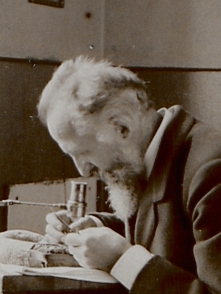Max Fürbringer (1846-1920)

Max Fürbringer was born on 30.01.1846, the first son of the public official, Karl Fürbringer, and his wife Hermine, in Wittenberg. Because of his job, Karl Fürbringer had to move frequently, so his children were raised by relatives in Gera.
Very early on Max began collecting biological specimens such as butterflies, ferns and mosses, but he also treasured coins and stamps, and was also interested in ornithology. In 1865 he began his formal studies in the natural sciences in Jena, then moved to Berlin where he wrote his dissertation about the bones and muscles of dinosaurs („Die Knochen und Muskeln der Extremitäten bei den schlangenähnlichen Sauriern“). The following year he returned to Jena in order to study medicine under Carl Gegenbaur.
Fürbringer became an assistant in the Anatomical Institute in Jena and received his state license in 1874. When Gegenbaur accepted a professorship in Heidelberg, Fürbringer followed him to become his prosector. He became a medical doctor in 1875 and just one year later was promoted to associate professor. He also married Fanny Bassermann in this year, and they eventually had two children.
Shortly after his wedding he accepted a professorship in Amsterdam, and in 1888, in Jena, but Fürbringer decided to return to Heidelberg 13 years later when he was offered a full professorship in the Anatomy Department. He was very engaged in the morphology and systems of birds, he also classified reptiles, fish and mammals, always considering their position in the whole of taxonomy.
Fürbringer was probably predestined for comparative anatomy because he pursued two degree programs: anatomy and zoology. In his obituary of Fürbringer, Herman Braus described him as a sharp-sighted man who worked continuously and industriously, often making personal sacrifices in order to expand his zoological collection. He also analyzed historical documents and literature.
His work concerning the brain and nerves was documented not only in writing; he also produced accurate and high quality drawings. Braus defined Fürbringer‘s work as the foundation of the modern „Segmentalanatomie“, the knowledge of muscles and their innervation. Fürbringer‘s slogan was „Mach es wenigen recht, vielen gefallen ist schlimm“ (try not to suit everybody, to please everyone is fatal). His sense of humor and his artistic talents where considered by Braus to be Fürbringer‘s most memorable qualities.
Max Fürbringer died unexpectedly on 06.03.1920 in Heidelberg.
To the digitized works by Max Karl Fürbringer
Requests, suggestions and criticism to Dr.sc.hum. Sara Doll





 Universitaetsbibliothek Heidelberg
Universitaetsbibliothek Heidelberg